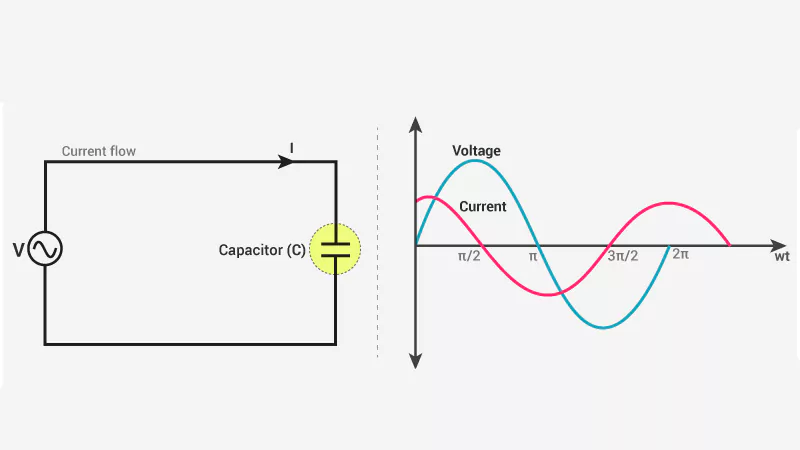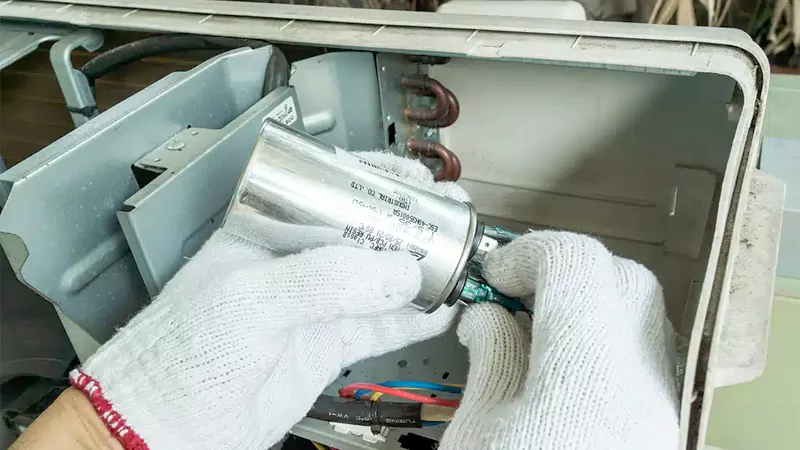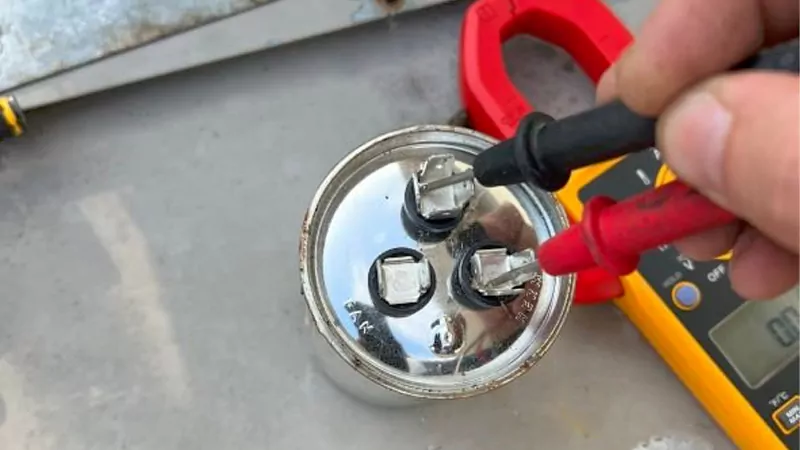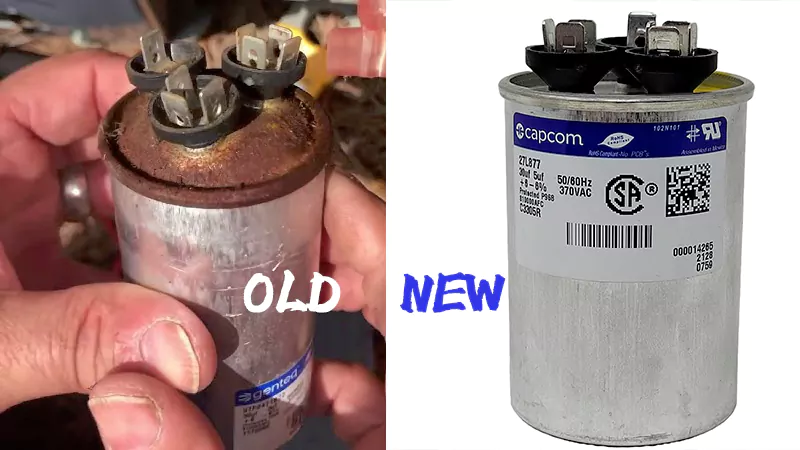Capacitors are essential components in any AC (alternating current) circuit, responsible for storing and releasing electrical energy to smooth voltage fluctuations and maintain stable operation. When a capacitor goes bad in an AC circuit, it can lead to erratic performance, overheating, or even complete system failure. So, how can you tell if a capacitor is bad in an AC system?
In this article, we will discuss the signs of bad capacitor on AC unit, symptoms of a bad capacitor in AC unit, and how to troubleshoot and replace a failing capacitor effectively.
What Is a Capacitor Used to in an AC Circuit?

- Store Energy: Capacitors temporarily store electrical energy in an electric field.
- Filter Signals: Smooth out voltage ripples and stabilize current in AC circuits.
- Phase Shifting: In some circuits, especially in motors, capacitors adjust the phase of currents to improve efficiency.
Capacitors are found in various applications, including power supply circuits, motor systems, and electronic devices. Over time, capacitors can degrade due to wear, heat, or electrical stress. Let’s dive into the symptoms of a bad capacitor on an AC unit.
Bad Capacitor Symptoms on AC Unit

Recognizing the signs of a failing capacitor in an AC circuit is essential for preventing further damage and ensuring consistent system performance. Here’s an in-depth look at the common indicators of a bad capacitor on AC unit:
1. Voltage Fluctuations
Capacitors play a critical role in stabilizing voltage in AC circuits. When a capacitor begins to fail, it loses its ability to regulate voltage, leading to noticeable fluctuations. These can manifest as:
- Flickering or dimming lights: Devices relying on the AC circuit may experience unstable power, causing visible inconsistencies in operation.
- Equipment malfunctions: Sensitive electronics connected to the circuit may reset, perform erratically, or even shut down unexpectedly.
- Voltage drops or spikes: Without the capacitor’s stabilizing function, you may observe irregular voltage measurements when testing the circuit.
If voltage fluctuations become persistent, the underlying cause could be a bad capacitor in AC unit.
2. Overheating Components
Another telltale symptom of a bad capacitor on AC unit is the overheating of nearby components. When the capacitor fails to store and release energy properly, it disrupts the energy balance in the circuit. This leads to:
Thermal damage: Prolonged overheating can damage other parts, reducing the overall lifespan of the circuit.
Increased heat dissipation: Resistors, transistors, or other circuit elements may absorb the excess energy, causing them to overheat.
3. Buzzing or Humming Sounds
A failing capacitor can produce audible warning signs such as buzzing, humming, or clicking noises. These sounds may arise due to:
Electrical arcing: Damaged capacitors can create sparks or arcs, which produce faint crackling or popping sounds.
Dielectric breakdown: The insulating material inside the capacitor deteriorates, causing irregular energy discharges that generate noise.
4. Failure to Start or Operate Smoothly
In motor-driven systems, such as those in industrial equipment or appliances, capacitors are responsible for starting the motor and maintaining efficient operation. A bad capacitor in AC unit can lead to:
- Hard starts: The motor struggles to initiate motion, often requiring several attempts.
- Slow operation: Motors may run below their optimal speed, reducing overall performance.
- Frequent stalling: The motor stops working intermittently due to insufficient energy supply.
These issues indicate the capacitor can no longer provide the necessary power boost or phase shift required for motor operation.
5. Frequent Circuit Breaker Trips
Capacitors that are shorted or degraded may cause erratic electrical behavior, leading to circuit overloads. Symptoms include:
- Breaker trips during operation: The circuit breaker trips unexpectedly when the system is under load.
- Recurring tripping after reset: Even after resetting the breaker, it trips again within a short period.
This is a common indicator of a capacitor bad on AC unit, as the faulty component can no longer manage electrical surges effectively.
6. Increased Energy Consumption
A capacitor operating below capacity forces the system to work harder to maintain stability, which can result in:
- Higher electricity bills: An inefficient AC circuit draws more power, increasing energy costs.
- Reduced energy efficiency: The entire system operates less effectively, wasting electricity.
Monitoring energy usage can help identify inefficiencies caused by a bad capacitor in AC unit.
7. Physical Damage
A visual inspection of the capacitor often reveals clear signs of failure. Look for the following:
- Bulging or swelling: The capacitor’s outer casing may expand due to internal pressure buildup.
- Leaking fluid: Electrolytic capacitors may leak electrolyte, leaving behind a residue near the terminals.
- Burn marks or discoloration: Heat damage or electrical arcing can cause visible burns on the capacitor’s surface.
Physical damage is one of the most obvious signs of a bad capacitor on AC unit and usually indicates the component is beyond repair.
How to Tell If Capacitor Is Bad on AC Unit

If you suspect a bad capacitor in AC unit, here’s a step-by-step guide to test and confirm:
Step 1. Turn Off the Power
Before inspecting or testing the capacitor, disconnect the AC power supply to prevent electric shocks.
Step 2. Inspect the Capacitor
Examine the capacitor for visible damage, such as swelling, leaks, or burn marks. If any of these are present, the capacitor is likely bad.
Step 3. Discharge the Capacitor
Capacitors can store a charge even after the power is off. Use a resistor or an insulated screwdriver to discharge the stored energy safely.
Step 4. Test with a Multimeter
Set your multimeter to the capacitance mode. Connect the probes to the capacitor terminals and compare the reading to the manufacturer’s specifications. If the value is significantly lower or shows “OL” (open line), the capacitor is faulty.
Step 5. Check Resistance
Using the multimeter’s resistance mode, measure the resistance between the capacitor terminals. A healthy capacitor will show a momentary resistance spike and then return to infinite resistance. A constant low resistance indicates a shorted capacitor, while infinite resistance suggests it’s open or dead.
Why It’s Important to Address These Signs Quickly
Ignoring the signs of a failing capacitor can lead to more significant issues down the line, including:
- Damage to other components: A bad capacitor puts additional stress on the rest of the circuit, increasing the likelihood of failures.
- Increased repair costs: Delaying maintenance can result in more extensive and expensive repairs.
- System downtime: Whether in industrial or household applications, a failing capacitor can lead to extended periods of inactivity.
By recognizing and addressing these signs of bad capacitor on AC unit, you can prevent further damage and maintain the efficiency of your system.
Common Causes of a Bad Capacitor in AC Unit

- Aging: Capacitors naturally wear out over time, typically lasting 5–10 years depending on usage.
- Overvoltage: Power surges or spikes can cause the capacitor to fail prematurely.
- Overheating: High ambient temperatures or heat from nearby components can degrade the capacitor’s dielectric material.
- Poor Quality: Low-quality capacitors are more likely to fail under stress or after extended use.
How to Replace a Bad Capacitor in AC Unit
- Identify the Specifications: Check the capacitance (measured in microfarads, µF) and voltage rating on the old capacitor. Purchase a replacement with matching specs.
- Disconnect and Label Wires: Carefully disconnect the wires connected to the capacitor, noting their positions.
- Remove the Old Capacitor: Use a screwdriver to loosen and remove the mounting bracket or clips holding the capacitor in place.
- Install the New Capacitor: Attach the new capacitor, ensuring all wires are correctly connected.
- Test the System: Turn on the power and check that the AC circuit or motor operates smoothly.
Preventing Bad Capacitors in AC Circuits
- Use High-Quality Components: Invest in capacitors with reliable build quality and rated tolerances.
- Install Surge Protection: Protect the circuit from voltage spikes with surge protectors.
- Ensure Proper Ventilation: Avoid excessive heat buildup by providing adequate airflow around components.
- Regular Maintenance: Periodically inspect and test capacitors as part of your routine system checks.
FAQs
How to know if a capacitor is bad?
To determine if a capacitor is bad, look for signs such as visible bulging, leaking electrolyte, or discoloration around the capacitor. If the capacitor appears swollen or shows signs of leakage, it is likely faulty.
Additionally, if the device or circuit is malfunctioning (e.g., power supply instability, overheating, or failure to start), the capacitor might be the issue. You can also test the capacitor with a multimeter set to the capacitance mode to check its value. If the capacitance reading is significantly lower than the rated value, the capacitor is likely bad.
How to determine if a capacitor is bad?
To determine if a capacitor is bad, first visually inspect it for physical signs such as bulging, leakage, or corrosion around the terminals. Use a multimeter to measure the capacitance and check if it matches the rated value.
A large deviation in capacitance or a very low reading indicates a faulty capacitor. Additionally, you can measure the capacitor’s leakage current using a leakage meter; if the current exceeds acceptable limits, the capacitor is damaged. If the capacitor is in a circuit, its failure might cause electrical issues like instability, reduced performance, or complete malfunction.
How often do capacitors go bad?
Capacitors degrade over time, with the rate depending on factors such as operating temperature, voltage stress, and environmental conditions. On average, electrolytic capacitors last between 2 to 10 years, while ceramic and tantalum capacitors can last much longer.
However, high temperatures, frequent power surges, or poor storage conditions can significantly shorten their lifespan. Capacitors in high-stress applications (e.g., power supplies, HVAC systems) are more likely to fail earlier. Regular maintenance and monitoring are important to identify and replace aging capacitors before they cause circuit failures or other issues.
What happens when a capacitor goes bad?
When a capacitor goes bad, it can cause several issues within the electronic circuit it is part of. A bad capacitor may lead to electrical instability, including voltage fluctuations or excessive current, which could cause the circuit to malfunction or fail. In power supplies, it may result in power loss or device failure to turn on.
Electrolytic capacitors that go bad can leak their internal electrolyte, potentially damaging the surrounding components or PCB. If a capacitor is part of a filter or timing circuit, its failure can disrupt signal processing or timing functions, affecting the overall system performance.
Will a bad capacitor trip a breaker?
Yes, a bad capacitor can potentially trip a circuit breaker. In some cases, a faulty capacitor may create a short circuit or cause a surge in current, which could trip the breaker to protect the circuit. This is more likely to happen with electrolytic capacitors, especially if they have leaked or become shorted internally.
Capacitors that are damaged or have high leakage resistance can cause excessive current draw, overheating, or even sparks, which could trigger a breaker. If your breaker trips repeatedly, it’s a good idea to check for bad capacitors in the circuit.
Can a capacitor look good but be bad?
Yes, a capacitor can look good physically but still be bad. Capacitors, particularly electrolytic types, may develop internal damage such as increased leakage current or reduced capacitance even if they show no visible signs like bulging or leaking. For example, a ceramic capacitor may appear intact but still exhibit increased leakage current.
The only way to confirm a capacitor’s condition is through electrical testing using a multimeter to measure capacitance or a leakage current meter. Even without visible defects, a capacitor may not perform as intended if it has aged, degraded, or been subjected to excessive stress.
Conclusion
Understanding the signs of a bad capacitor on AC unit and recognizing the symptoms of a bad capacitor in an AC unit are fundamental for maintaining the reliability and longevity of your electrical systems. A capacitor is a small but vital component that ensures the stability and efficiency of AC circuits, and overlooking early signs of failure can lead to cascading problems, including system downtime, increased energy costs, and even damage to other critical components.
By learning how to identify and address issues such as voltage fluctuations, overheating components, unusual sounds, and physical damage, you can take proactive steps to keep your circuits in optimal condition. This guide has outlined practical diagnostic techniques and explained the symptoms of a failing capacitor, enabling you to pinpoint the issue with confidence.
In addition, working with high-quality replacement capacitors and following proper testing methods ensures that your electrical systems remain efficient and reliable for years to come. If you suspect a problem but lack the necessary tools or expertise, consulting a qualified technician can save time and prevent potential risks.